
Tetraodontidae is a family of primarily marine and estuarine fish of the order Tetraodontiformes. The family includes many familiar species variously called pufferfish, puffers, balloonfish, blowfish, blowies, bubblefish, globefish, swellfish, toadfish, toadies, honey toads, sugar toads, and sea squab. They are morphologically similar to the closely related porcupinefish, which have large external spines. The scientific name refers to the four large teeth, fused into an upper and lower plate, which are used for crushing the hard shells of crustaceans and mollusks, their natural prey.
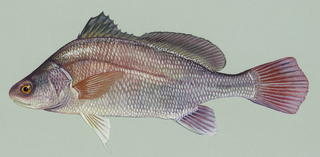
The freshwater drum, Aplodinotus grunniens, is a fish endemic to North and Central America. It is the only species in the genus Aplodinotus, and is a member of the family Sciaenidae. It is the only North American member of the group that inhabits freshwater for its entire life. Its generic name, Aplodinotus, comes from Greek meaning "single back", and the specific epithet, grunniens, comes from a Latin word meaning "grunting". It is given to it because of the grunting noise that mature males make. This noise comes from a special set of muscles within the body cavity that vibrate against the swim bladder. The purpose of the grunting is unknown, but due to it being present in only mature males and during the spawning season, it is assumed to be linked to spawning.
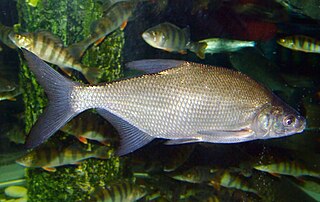
The common bream, freshwater bream, bream, bronze bream, or carp bream, is a European species of freshwater fish in the family Cyprinidae. It is now considered to be the only species in the genus Abramis.

The Congo clawless otter, also known as the Cameroon clawless otter, is a species in the family Mustelidae. It was formerly recognised as a subspecies of the African clawless otter.
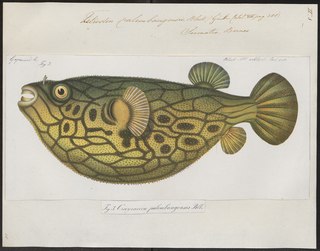
Pao palembangensis, is a species of freshwater pufferfish native to Thailand, Laos, Malaysia and Indonesia in Southeast Asia. Its commonly called the humpback puffer or dragon puffer.

Chonerhinos naritus, the bronze pufferfish or yellow pufferfish, is a species of pufferfish native to Southeast Asia, where mainly found in estuarine and coastal habitats. This species grows to a length of 28.5 centimetres (11.2 in) TL, but otherwise it generally resembles the smaller and more strictly freshwater Auriglobus pufferfish. This predatory species feeds on other fish, crustaceans and snails.

Bryconops is a genus of freshwater fish in the family Iguanodectidae from South America. Various species of tetra are amongst its ranks, and are sometimes seen in the aquarium trade.

Eels are ray-finned fish belonging to the order Anguilliformes), which consists of eight suborders, 19 families, 111 genera, and about 800 species. Eels undergo considerable development from the early larval stage to the eventual adult stage, and most are predators.

The Texas shiner is a species of ray-finned fish in the genus Notropis. It is found in the Colorado River to Rio Grande drainage from Texas and northeastern Mexico and the Rio Salado and Rio San Juan systems in Mexico to the lower Pecos River in Texas.

The Amur catfish, or Japanese common catfish, Silurus asotus, is a species of catfish (sheatfish), family Siluridae. It is a large freshwater fish found in continental East Asia and in Japan. It prefers slow-flowing rivers, lakes, and irrigation canals. Its appearance is typical of a large silurid catfish. Larval S. asotus specimens have three pairs of barbels, while adult fish have only two pairs ; second pair of mandibular barbels degenerates. This species grows to 130 cm (51 in) in total length.
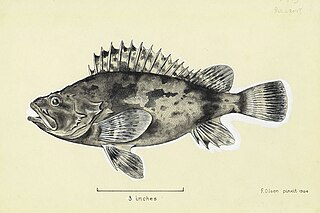
The bullrout, also commonly called freshwater stonefish or kroki, is a pale yellowish to dark-brown coloured fish that lives in tidal estuaries and slow-flowing streams in eastern Australia, from Southern New South Wales to northern Queensland, Australia. It has on a very infrequent occurrence been caught at sea. Its spines are venomous. It is the only member of the genus Notesthes.

Auriglobus modestus, the bronze puffer or golden puffer, is a ray-finned fish in the family Tetraodontidae. It is found in the middle parts of rivers to their estuaries in southeast Asia, including Cambodia, Laos, Thailand, Vietnam, Malaysia and Indonesia. It grows to a maximum length of 10.6 cm (4.2 in) and feeds on small invertebrates, seeds, fish scales and small fish.
Coregonus restrictus is an extinct freshwater fish from the family Salmonidae. It was originally discovered in Lake Morat, Switzerland, in 1885. In 2008 it was included on the IUCN Red List by J. Freyhof and M. Kottelat. It was first described by Fatio.
Cyperus amabilis, commonly known as the foothill flatsedge, is a species of sedge that is native to tropical and sub-tropical areas in the Americas, Africa and Asia.
Auriglobus nefastus, known as the greenbottle pufferfish, is a species of pufferfish in the family Tetraodontidae. It is a freshwater species native to Asia, where it may be found from the Mekong basin to Indonesia. It occurs in fast-flowing waters of rivers and streams, although it is known to enter flooded forests and plains when river water levels rise. It feeds on the scales and fins of other fish and reaches 13 cm SL. The common name of the species comes from its coloration, which ranges from light green to golden.
Auriglobus remotus is a species of pufferfish in the family Tetraodontidae. It is a tropical freshwater species known only from Indonesia that reaches 6.2 cm SL. Like the other four members of Auriglobus, it was previously classified in the genus Chonerhinos.
Auriglobus silus is a species of pufferfish in the family Tetraodontidae. It is a tropical freshwater fish known only from Indonesia that reaches 8.2 cm SL. Like the other four members of Auriglobus, it was previously classified as a species of Chonerhinos.

Iguanodectidae is a family of freshwater fish in the order Characiformes that lives in South America. It is home to the subfamily Iguanodectinae and the monotypic Bryconops clade. Several species in the family, such as the green line lizard tetra, the tailspot tetra, and the orangefin tetra, are sometimes taken as aquarium fish.
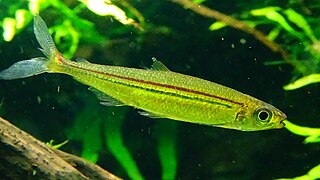
Iguanodectinae is a subfamily of small freshwater fish in the family Iguanodectidae. They are most prominently found in the Amazon river basin and its major tributaries, but they are also known from the Tocantins, Orinoco, and Paraguay rivers. It has two genera, Piabucus and Iguanodectes. Some species in the subfamily are taken from the wild for aquariums, like the red- and green-line lizard tetras. There is minor, but ongoing, debate regarding its taxonomy.
Ward's long-eared bat is a species of vesper bat in the family Vespertilionidae. It is found in mountainous regions of South Asia and adjoining regions.











